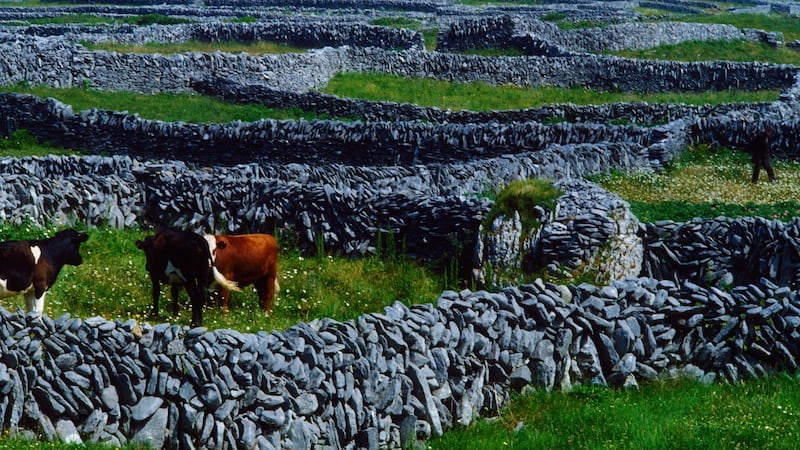The results of an innovative project aimed at preserving the unique biodiversity and tourism appeal of the Aran Islands will be presented at a two-day conference on Inis Mór on September 11th and 12th. The aim of the conference is to demonstrate how local farming knowledge and experience, along with scientific expertise, can be harnessed to overcome some of the challenges of island farming and to improve the conservation status of Special Areas of Conservation (SACs).
The AranLIFE project is a four-year EU LIFE demonstration project which has operated on the three Aran Islands since 2014 and is now drawing to a close. LIFE is the EU’s financial instrument to support environmental, nature conservation and climate action projects.
"The Aran Islands are extremely important from a biodiversity point of view," says Teagasc research officer Daire Ó hUallacháin. "Under the EU Natural Habitats directive, 75 per cent of the islands have been designated as special areas of conservation. Farmland on the island has been created by generations of farmers, but it is suffering, with fields being abandoned and taken over by scrub, with a consequent loss of grassland and biodiversity."

AranLIFE project manager Dr Patrick McGurn explains that the Aran Islands' dense web of high field wall systems are home to some of Ireland's best dry grassland habitats. While only 40sq km in area, the Aran Islands are home to approximately 500 plant species – equal to nearly half the total number of species within the whole island of Ireland. A quite remarkable statistic when it is considered that there are no bogs, mountains, rivers and woodlands on the islands that could contribute to this species diversity.
Farming systems with associated high biodiversity are known as high nature value (HNV) farmland and are vital in maintaining Ireland and Europe’s biodiversity. However, these systems face difficulties. Abandonment or degradation of farmland and socio-economic decline are long-standing threats for such extensive and nature-friendly farming systems.
Fragmented
The Aran Islands face many of these issues: highly fragmented farms, low stocking rates, high labour intensity and poor economic return. “A decline in agriculture on the islands is worrying as agriculture has many benefits, not only in producing food and maintaining biodiversity but also in conserving the wonderful landscape with its stone walls and historic monuments that 300,000 people a year come to see.”
The main aim of the project was to work with local landowners to devise a means to restore the fields to their previous condition
Funding was approved for the €2.6 million project in 2014. The overall project was led by the Department of Arts, Heritage and the Gaeltacht, with Teagasc as an associated partner. Other partners include the Department of Agriculture, Food and Marine, Fáilte Ireland, Heritage Council and Galway County Council.
The day-to-day operation of the project is run by a project team, which is based in an office on Inis Oírr. Led Dr McGurn, the team comprises Dr Amanda Browne, scientific/technical officer; Gráinne Ní Chonghaile, administration and finance officer; and Louise Duignan, a Teagasc-Walsh Fellowship PhD student at the Institute of Technology, Sligo.
The main aim of the project was to work with local landowners to devise a means to restore the fields to their previous condition. These required the clearing of boreens, installation of fresh water collecting systems, and the clearing of scrub from the fields. Each field was scored by ecologists and farmers were offered incentives to improve them.
“This results-based approach is relatively new,” says Ó hUallacháin. “Instead of providing funding for certain actions, it was based on outcomes. The farmers were very enthusiastic about it.”
Specific issues
Dr McGurn describes some of the specific issues addressed by the project. “We worked with 67 farmers,” he says. “The farms are very fragmented and are connected by small, narrow boreens, many of which had become blocked. Also, there are no rivers or streams on the islands to provide fresh water. In all, 28km of boreens were cleared, 90 hectares of scrub cleared, and 1,100 hectares of grasslands were improved. Over 220 rainwater catchers were provided. We also worked with Teagasc, IT Sligo and the local veterinary surgeon to look at the nutritional status of the grasslands and supplemented them accordingly using specific mineral supplement blocks.”
The project has already resulted in a noticeable increase in biodiversity, with many plant species returning to the fields. “The main aim of the conference is to promote this model and show how it can work for other high nature value areas around the country. The project has been a great success for a relatively modest budget. It will demonstrate how difficulties like a lack of water, small fields, and the most fragmented farming land in Ireland were overcome. The farmers may not be able to compete with intensive farms, but they can provide environmental services such as clean water, cleaner air, and improved biodiversity. We don’t have a means of valuing that but society demands it and the farmers deserve to be rewarded for it.”










